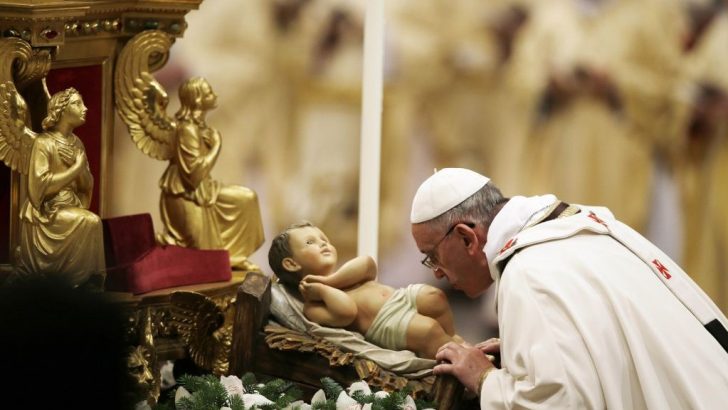The View
On Monday, the Church celebrates the great moment of the first revelation of the Messiah to all nations and peoples: the Epiphany. Traditionally considered even more theologically significant than the Nativity, this was the moment in time when Christ was revealed as not only a Messiah for God’s chosen people, but for all peoples.
Whereas angels were the messengers that brought the news of Christ’s birth to the Jewish people – as represented by the shepherds – the star heralded the great news to the Magi, or wise men, representing the Gentiles. These three wise men were astronomers who noted and understood the significance of the appearance of the star and were not deterred from following it.
Their journey in seeking the Christ-child, and what we can only imagine of their perseverance in their arduous trek, calls to mind St Augustine’s reflection: “Thou hast formed us for Thyself, and our hearts are restless till they find their rest in Thee.”
Leaving behind their homes, their commitments, dropping everything in their quest to follow Christ, they did not rest till they found the place where the child lay.
Tradition
The three wise men – by tradition representing all the three known continents at the time, Europe, Asia and Africa – remind us that though the Jewish people were chosen by God, and specially loved for that reason, all, whether Jew or Gentile, are made in God’s image and formed by God for himself.
This sign of the extension of God’s salvation to people of all nations bears great significance in our times of religious and racial persecution.
It was the early Christian Church – through God’s revelation to St Peter that no man was to be considered unclean or unworthy to associate with – that broke the taboo of Jew sitting down to eat with Gentile.
In the Council of Jerusalem, Peter established that the Gentiles were not bound by the Old Law and that the Gospel message was also for them. The Church then, governed in an unbroken line from the first Pope, Peter, still stands as a sign of the universality of God’s offering of faith and salvation: it is for all peoples, regardless of origins or race. Each is treasured as a child of God and member of His Church.
Pope emeritus Benedict XVI tells us that in addition to representing peoples of all origins, Caspar, Melchior and Balthasar also by tradition represent the different phases in human life: youth, maturity and old age. As the former Pope says, the various stages of human life find their true meaning and inner unity in companionship with Jesus.
This too is reflected in the Church’s teaching on the sanctity of life from conception to natural death, which also has a special significance in our times and now, sadly, in our own country.
While the persecution of people on racial or religious grounds is often visible, the persecution of people on the grounds of age – whether immaturity or old age – is hidden in our modern culture. Abortion and euthanasia are grievous offences against the most vulnerable in our society.
The image of the Magi bowing before a tiny infant stands in stark contrast to the offence of attacking the most vulnerable through the means of abortion and euthanasia. In the great paintings showing the visit of the Wise Men, the central focus is usually on the Christ-child in Mary’s arms and the oldest of the Magi, who is depicted as kneeling reverently before the infant, offering his gift. In the image we see each end of the age spectrum gazing respectfully – and lovingly – at the other. If only our society would mirror this image.
As if the significance and importance of this event were not already emphasised enough, we also have the gifts born by the Magi to further enlighten us that the child they sought was King, God, and Saviour.
Gold signifies Christ’s royalty, also reinforced by the town in which he was born: Bethlehem. This was prophesied by Micah, about 700 years before the birth of Christ: “But you, O Bethlehem Epherathah, who are little to be among the clans of Judah, from you shall come forth for me one who is to be ruler in Israel.”
This also shows what Pope emeritus Benedict XVI calls the paradox in God’s actions: that he takes what is small and insignificant by human standards and raises it up.
Bethlehem, as a small town, became a royal city. David, whom the city recalls as king, was the youngest of Jesse’s sons and least likely to be king material, but was raised up by God to rule. A child born into a carpenter’s family was really the Saviour of the world.
So, too, God promises to do great things for us. In Matthew 17:20 Christ says to his disciples: “If you have faith as a grain of mustard seed, you will say to this mountain, ‘move from here to there’, and it will move; and nothing will be impossible to you. All these seeming paradoxes remind us that God’s ways are not our ways.”
Before Simeon’s prophecy that a sword would pierce Mary’s own soul too, the gift of myrrh pointed to Christ’s suffering and death”
The significance of Christ’s place of birth was also prophesied by a non-Jew and worshipper of other gods. Balaam was used by God to point towards Christ’s coming: “a star shall come forth out of Jacob and a sceptre shall rise out of Israel” (Num 24:17). The pagan, intending to curse the Jewish people at Balak’s behest, ended up confessing that Christ was King.
The gift of Frankincense signifies the recognition of Jesus as God.
Frankincense, an aromatic resin derived from the sap of the Boswellia tree species, was used in religious rites from earliest times. In presenting it to Jesus, the Magi were recognising Jesus’s divinity as well as fulfilling Isaiah’s prophecy that “they shall bring gold and frankincense and shall proclaim the praise of the Lord.”
Before Christ’s baptism in the River Jordan when a voice from heaven proclaimed: “This is my beloved Son, with whom I am well pleased”, before his first miracle worked at Cana, this was the first moment the world recognised Christ as Lord and bowed humbly before him.
Finally myrrh is perhaps the most intriguing of the gifts. Believed to have been worth more than gold in biblical times, it is a resin derived from trees belonging to the Commiphora genus.
Analysis
A recent analysis of the inorganic and organic constituents of myrrh published in the Saudi Pharmaceutical Journal points to its medicinal properties and use as such in traditional ancient medicines of India, China, Rome, Greece and Babylon. It was used for traumatic pain and inflammation, having anti-inflammatory as well as analgesic properties.
The presentation of myrrh in the stable in Bethlehem spoke of Christ as Saviour as well as pointing towards his passion – the means by which he would save the world.
In St Mark’s account of the crucifixion, we are told that while hanging on the cross, Jesus was offered wine mixed with myrrh, which he refused. He suffered the full agony of his crucifixion without any sedation or dulling of the pain.
Again at his burial, Nicodemus brings myrrh and aloes to anoint the body of Jesus. Before Simeon’s prophecy that a sword would pierce Mary’s own soul too, the gift of myrrh pointed to Christ’s suffering and death – and our salvation.
Finally, in meditating on the three figures of Caspar, Melchior and Balthasar and the significance of their gifts, I was taken by the description in Butler’s The Lives of the Saints. In it, he recognises the theological significance of the Magi’s gifts, but states that their “far more acceptable presents were the holy sentiments and affections of their souls; their fervent charity, signified by gold; their devotion, figured by frankincense; and the unreserved sacrifice of themselves by mortification, represented by myrrh” – gifts that we too can offer the Christ-child during these last few days of Christmas.


 Maria Steen
Maria Steen
